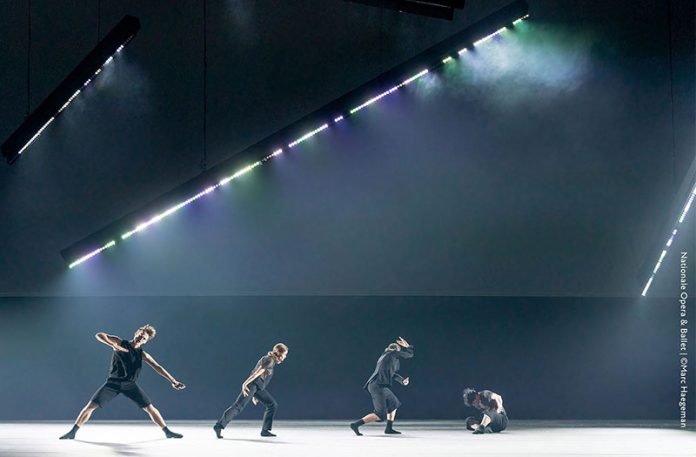Full Frontal was the final work in Four Temperaments, a performance featuring the work of four choreographers, and was lit by Yaron Abulafia who enlisted the help of 40 Robe Tetra2 moving LED battens and an automation system.
The Tetra2s assisted Abulafia in sculpting his daring and combative light show for the 21-minute Full Frontal performance, which was created in close collaboration with Choreographer Juanjo Arqués, set and Costume Designer Tatyana van Walsum and Dramaturg Fabienne Vegt.
Choreographer Arqués underlined the relevance of lighting: “Yaron proposed a beautiful light sculpture made of moving beams that are floating in space. The idea of having such a monumental structure over the dancers’ heads allowed me to drill down deeper into emotions, build tension, and achieve infinite light options, empowering the aesthetics and the dramaturgy of the piece.”
He specifically wanted to create walls of light with the Tetra2s as they descended from the ceiling and tilted in different directions and trajectories interacting with and confronting the dancers effectively providing extra kinesis for a 13-minute section of the work.
“This piece was a rollercoaster,” commented Abulafia. “Driven by the anxieties, unknowns, and complexities of events like full-scale war, the global pandemic and other destabilising factors like ongoing natural disasters and climate change. I needed to accentuate all this expression, intensity and emotion, all the peaks and breakdowns, strengths and vulnerabilities of the performance with a stark and different style of lighting.”
The stage space was defined by some special stretched plastic 9-metre-high walls installed 2.6m off the ground and 22m apart widthways, with special side lighting. The Tetra2s were rigged on six trusses measuring 10m, 9m or 8m in length, all flown with different orientations in different parts of the overhead grid. The Tetra2 fixtures were onstage for 13 minutes of “Full Frontal” creating barriers, ruins and walls between which the dancers would dodge and spiral to points of no return.
He has worked with the luminaires previously on a few productions. “I needed this technology from Robe as it is a powerful light source that looks and feels properly tactile in the contexts in which I wanted to use it, and I knew it would also provide the right architectural elements,” he explained. “The Tetra2 trusses really essentially brought six extra dancers onstage.”
On stage tech time was extremely tight as the three other pieces also all had to have their allotted slots. Being one of the two new productions of the four also meant more unknowns and therefore more challenges.
Arqués also appreciates Abulafia’s organisational skills, revealing how Abulafia produced drawings of each of the scenes that explained where the light sources would be coming from, the patterns they would make on the floor, and other technical information like timings, all of which “made it very comfortable for me to create the movement material in the studio”.
It was Arqués and Abulafia’s first collaboration, but both are already looking forward to the next time. “Abulafia is a passionate artist who loves working as part of a team, enjoys every part of his job, and delivers a unique signature every time,” concluded Arqués.
Lighting was programmed via a grandMA3 console and was run completely manually following and feeling the pace and timing of the visual and musical cues. Dutch National Ballet Director, Ted Brandsen, noted: “Lighting played an essential role in the success” of this production, adding that while coordination between the technical elements, moving light fixtures and other scenic elements plus the dancers’ movements and choreography was a huge challenge of its staging, he was delighted with the results. It was a very innovative, expressive and new way of experiencing dance.”
The Tetra2s were supplied to the production by Ampco Flashlight. The Dutch Ballet Orchestra was conducted by Matthew Rowe and accompanied the soundscape, and the sound designer was Ian Dearden.






